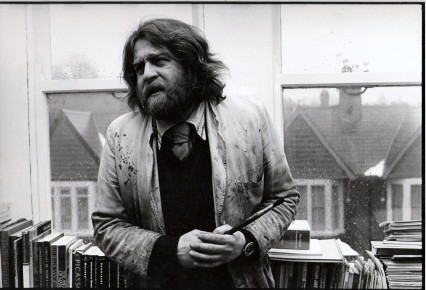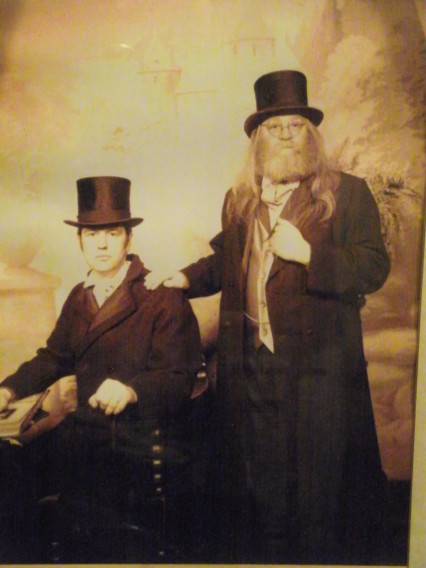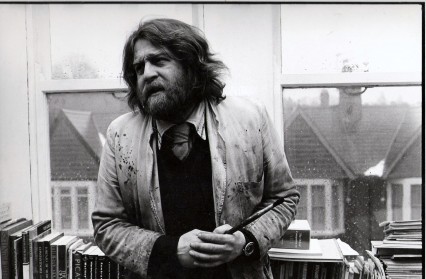In the second part of our tribute to Welsh artist Tony Goble, life-long friend Martin Hamer talks to writers, artists and critics about Goble’s body of work, his influence, and his legacy.

In 1979 Tony Goble took up his post as Artist in Residence at Llanover Hall. Artist Gareth Griffiths has kindly provided this insight into Tony’s life at this time.
LANOVER HALL 1979
I was going to Life Drawing at Llanover Hall, and there I met the new Artist-in-Residence Tony Goble. He had a little studio on the top floor which was like a beacon, filled with art books and paintings on the go. It was so exciting when you went in, smelling the oil paint, your eye absorbing every detail. He’d just moved to Cardiff, looking for a house – his family were still in North Wales. I’d chat for hours with Tony; he always had all the time in the world for you.
COLLINGDON ROAD STUDIOS
In the early eighties, Tony had a big studio in Collingdon Road. He offered to let me share it and split the rent. It was like something out of Charles Dickens, tons of books and paintings, and a couple of coffin-like fish tanks. The fish had grown huge. You’d see them looming around in the murky depths and when you were alone there at night you’d turn around from your painting and they’d all be up at one end, watching you.
Tony was doing very powerful, earthy paintings then – mixing wax with oil paint and applying it very thickly. He told me some of the faces were drinkers from the Royal Oak. I was painting a big picture called Ship Of Fools using a traditional underpainting & glazing technique which fascinated him. The painting still hangs in Janice’s front room.
We were usually there together painting in the evening, the rest of the building empty. We had only two tapes; Tony had Bob Dylan’s New Morning which he played over and over again. I had a tape of Hancock’s Half Hour The Poetry Society about Hancock becoming a bohemian poet. Tony adored the piece and played it all the time. I think he always played up to the bohemian image and felt a genuine rapport with it. At ten we’d close up and go across town to the Royal Oak where Tony would have several pints of S.A. to my one.
CITY ROAD STUDIO
The loft studio round the back of the Richmond Art Centre on City Road, next door to the massage parlour, had a real Van Gogh flavour to it and again the glorious smell of oil paint. I used to call in and see Tony. He lived on this horrible black coffee, and I’d take him some more palatable stuff so at least I had a decent cuppa. I remember him working on a picture of the resident ghost, a red-headed man who’d hanged himself there years ago.
LLANOVER HALL 1985
For several years in the mid- eighties had a top floor studio overlooking Charles Street and Tony would call in every Sunday morning for a chat after he’d been to Mass in the Cathedral. He offered me my first one-man show at Llanover Hall in 1986, and gave me a lot of support to put it on.
I moved away from Wales for many years, but we reconnected when he was kind enough to offer me a little job teaching at Llanover Hall. The last time I saw him was at his desk. The room was packed with kids as usual on a Saturday morning and Tony was in the office playing Bob Dylan’s Bringing It All Back Home. It was the last day of term and he seemed, for once, a bit tired. The following Saturday I was in Bath and received a phone message to say Tony had just passed away unexpectedly. It was an enormous shock.
Some months later I ended up taking over Tony’s job as warden and gallery organiser. His was an impossible act to follow but I tried to keep the gallery going in his spirit. Tony always stood up for art and artists, he believed passionately that it was important work. His art and his life were indivisible. But he was never pompous or pretentious. He loved taking off on flights of fancy. When we went in my car to the 1988 National Eisteddfod in Newport, he was enjoying the day and didn’t want to cut it short. So on the way home he recalled something he’d read in The Echo about a man in Rumney who’d filled his garden with hundreds of gnomes. We took a diversion and eventually located the house. Tony, in his beret, knocked the door and earnestly explained to the woman of the house that we were artists and would love to see their wonderful garden. Her husband was out but she invited us in and served us tea and biscuits in this spectacular Disneyland of gnomes in the middle of Rumney.
Tony’s wonderful wife and one-woman support crew, Janice, put on a retrospective of his work at Llanover Hall about two years ago. The building was packed to the rafters. Everyone held him in such high regard; they really loved him and missed him like a member of their own family.
*
As Tony became well established at Llanover Hall, he became friends with David Moore, curator of Brecknock Museum and Art Gallery from 1992 until 2006. In a recent email David described Tony’s role at Llanover to be a benign presence at the centre of frenzied creative activity involving young people.
The gallery at Brecon showed Tony’s work with the Welsh Group on many occasions. He also exhibited in Jazz Trio, an exhibition for Brecon Jazz. One year Tony designed the posters for the festival. He launched the Museum’s 2000 Brecon Jazz exhibition by mounting a platform at the top of compilation of found sculptures. He climbed to his launch position, to the slow-hand clapping of the audience, and delivered his address to the throng.
David Moore gave the eulogy at Tony’s funeral and wrote his obituary for The Independent – Tony Goble: Allegorical Painter & Champion of the Visual Arts in Wales. My thanks to David for his permission to quote from his piece:
Tony Goble was an influential, charismatic and highly respected figure in the visual art world of Wales. Projecting a stylish image, with his red braces, wide-brimmed hat and long white beard, he was chair of prominent artist groups, an inspiring art teacher and a shrewd champion of the visual arts. He was a Christian, a family man and a supportive friend. The imagery of his paintings was inextricably bound up with his life.
Cicely Hey became an influential friend and she persuaded Goble to submit work to The Royal Academy. He was given an exhibition at Oriel Bangor, was elected a member of the Royal Cambrian Academy and went on to be chairman of The Welsh Group.
His work is essentially allegorical. Painting he said, “is somewhere between seeing and believing; somewhere between dreams and the work-a-day world.” His works are characterised by pure glowing colour, visual wit and a disregard for perspective.
For him painting was a spiritual activity, “I see my paintings as poems, as prayers if you like.”
The central figure in most of his work was, unmistakably, a caricature of himself as a biblical prophet or monk. Intrigued by angels, he regarded them as muses. Goble’s art might, contentiously, be regarded as “postmodernist” in the sense that it consciously, playfully and eclectically referenced imagery from the medieval period to the present. Marc Chagall, Joan Miro, Emile Nolde, Franz Marc and Odilon Redon would all seem to have contributed to his distinctive style.
He was concerned to develop visual art links abroad. In 1981 he had travelled to the Soviet Union on a fact finding-mission for South Glamorgan County Council. More recently he visited the Venice Biennale and travelled to Chicago on behalf of the Welsh Group. He exhibited in Ireland, France, Belgium, The Netherlands, Germany, The Czech Republic and The United States.
By 1995 Janet and I had the Internet and I did try to find Tony Goble but the search engines were pretty poor in those days. Janice and Tony had been searching for me too, I later learned, but I had left no trail.
They looked for me on the occasion of their 25th wedding anniversary. Janice had organised a surprise party and, to get Tony out of the way whilst people were arriving, sent him into town to buy cheese. He did not return home until late at night when all the guests had gone. Writer Twm Miall and Dorian Goble spent the afternoon checking Tony’s local haunts but failed to find him. He had met a friend in town and the two of them had gone on a pub crawl. I missed Tony’s party but so did he.
I’m told that the following year Tony had flown to The Soviet Union as part of a mission for The County Council. He got rather drunk on the plane and, as he alighted, was met at the bottom of the steps by what looked like a member of the KGB. The man sternly showed Tony into an office where he thought he was going to be arrested. Instead the chap produced a bottle of vodka from a desk drawer and the two men clinked glasses and managed some sort of chat.
Tony had many friends both in and out of the artistic community. In a recent email Twm Miall shared his memory of one such group, I was lucky enough to have befriended three eminent Welshmen who were fantastic characters, unique and original, but who have sadly left us. It was quite an interesting mix: Tony the archetypal artist, W.S. Jones the playwright and motorbike enthusiast and collector, and Orig Williams, or El Bandito, the professional footballer/wrestler and raconteur. All three had one thing in common: their fondness of a good pint, stimulating conversation and the ‘craic’ in an old-fashioned pub.
*
Another friend was the poet Paul Henry whom I acknowledge for the following memoir.
Extracts from ‘Recollections of Mr Goble, by his close acquaintance and confidant, Mr R.G. Matlock, Somerset Place, Bath.’
Dining with Mr Goble:
For the past fifteen years, each Wednesday, in the Welsh capital where he resides, Mr Goble and I have indulged in a mid-day breakfast at the Wellfield Diner, followed by an afternoon tour of the charity shops which line both sides of Wellfield Road and, in the main, Albany Road. Creatures of habit, I think our ghosts will haunt the paving stones of these roads long after Llinos and Debbie, our hosts at the aforementioned eating house, have hung up their aprons. I don’t know where to begin with my dear friend, Mr Anthony Barton St John Goble, as he occasionally prefers to be known.
His favourite lunch is Bacon Baguette With Six Cloves of Garlic while I am partial to my regular, A Face (a cooked English breakfast with two eggs for eyes, a tomato nose and Cumberland sausage mouth; smiling, or not).
Things happen to him:

A sound barometer of human temperament is the reaction to my friend’s beard. Optimists smile, pessimists avert their eyes. I suspect beards will become fashionable again, perhaps in the next century, and less of a spectacle. On occasions it seems almost everyone in Cardiff knows Mr Goble. He’s taught half its population to draw and others he knows from pubs and funerals. It is not an exaggeration to say he that he makes a village of the city. And it is indeed an honour to be invisible by his side as he stops in mid shuffle, to finish a story with wild, theatrical gestures; or when an impression of eccentricity is augmented by his continuous bowing in order to retrieve elastic bands, dropped by postmen to the pavement. (Each new cast-off is wrapped around an enormous elastic-band ball when he gets home.)
Crossing the road is easy with Mr. Goble. You simply ensure he is nearest the oncoming flow of carriages. Impressed by his upheld cane, they invariably stop for him, albeit sounding their horns. But let me affirm, for all outward appearances, Mr Goble is the wisest man I know.
Things happen to Mr Goble. Only last week, someone threw a potato at him, from a passing carriage. (This he took home and cooked.) He has also been shot at, not three Wednesdays ago, by one of these fangled air-rifles, as he bent down to pick up a trick pound coin which had been glued to the pavement outside the ‘Tenovus’ store. But he takes all such happenings in jest. I recall, on one expedition, his being chased around the ‘Red Cross’ store by an elderly lady wielding a can of fresh air. She had mistaken my confidant for another gentleman whose darker beard, unlike my friend’s russet appendage, belonged more to a young Rasputin. This character had broken wind, loudly, while standing next to Mr Goble as he perused the second-hand books. He had then scurried away, leaving my wrongly accused friend, in the zone of the crime, so to speak. Ever the wonderer, the injustice simply amused him.
Three words on Mr Goble’s Religious and Cultural Affiliations:
Mr Goble is often keen to describe himself as a “Welsh Catholic Jew.” Oh… I think that’s my maid at the door.
Janice Goble confirmed Tony’s idiosyncratic shopping habits. He once went out to buy some wire wool to clean up a picture frame and returned with a baby grand piano.
*
Peter Wakelin wrote the obituary for The Guardian and has given me permission to quote from it. He described Tony as a much-loved educator and one of the most admired artists in Wales. He went on to say: Goble’s work was utterly individual, yet it belonged to an artistic family that runs from European folk painting through William Blake and Marc Chagall to Cecil Collins, Ken Kiff and others. He might be termed a magical realist: his subjects were his own life and everyday surroundings transformed by free association into other-worldly narratives. He plucked imagery from many sources, capturing birds, boats, medieval sculptures and Coptic icons to place alongside his own pictorial persona. His vitality of form and vividness of colour were seductive, and his worlds were persuasive, yet his mysterious images remained richly open to interpretation.
Tony’s life was itself an artistic creation. Goble became an archetype, with bird’s-nest beard, long hair, large hats and bicycle.
Goble’s work is in the collections of the National Museum of Wales, Leeds Museum, Swansea’s Glynn Vivian Art Gallery and the Contemporary Art Society for Wales, among others. A major exhibition, Dream-Seeds, was held at the Glynn Vivian in 1995, and he showed regularly with the Welsh Group and at the Royal Cambrian Academy, the National Eisteddfod and the Royal Academy in London. In 2004, a retrospective at Llanover Hall – 25 Years in Residence – spilled from the gallery into almost every room. Friends produced, alongside the exhibition catalogue, a booklet of unselfconscious tributes to Goble’s inspiration, kindness and support.
*
In 2010 I was in touch with Janice Goble. She told me of Tony’s unexpected death in April 2007 when they were visiting Brecon Cathedral. He suddenly declared himself to be short of breath. Janice summoned an ambulance. The medics didn’t seem to think there was much wrong but took him to the hospital anyway. Janice followed in the car only to be told the worst possible news on her arrival.
It has been a joy for me to recall my association with Tony Goble and to learn he had lived such a rich and fulfilling life in the years when we lost touch. Strange to think that, quite independently, we had both abandoned our atheism, held senior teaching posts and were both known for our red braces.
Deputy Head Martin Thomas said to me as I was quitting the teaching profession to pursue my writing ambitions and follow my business interests.
Teaching was never really enough for you was it, Martin?
He was right. I had marvellous days teaching but after twenty five years I couldn’t anymore live to the demands of the school bell; the regularity of it all. You were supposed to go every day. Teachers were drowning in paperwork. It was only going to get worse.
The day John Lennon was killed I told the Head I couldn’t teach that day and was going home. I suppose I was a bit like Tony all those years ago in the diamond tool factory. The Diamond Factory. Now that would be a good title for the memoirs of a teacher and an artist. Anthony Barton St John Goble was both.












